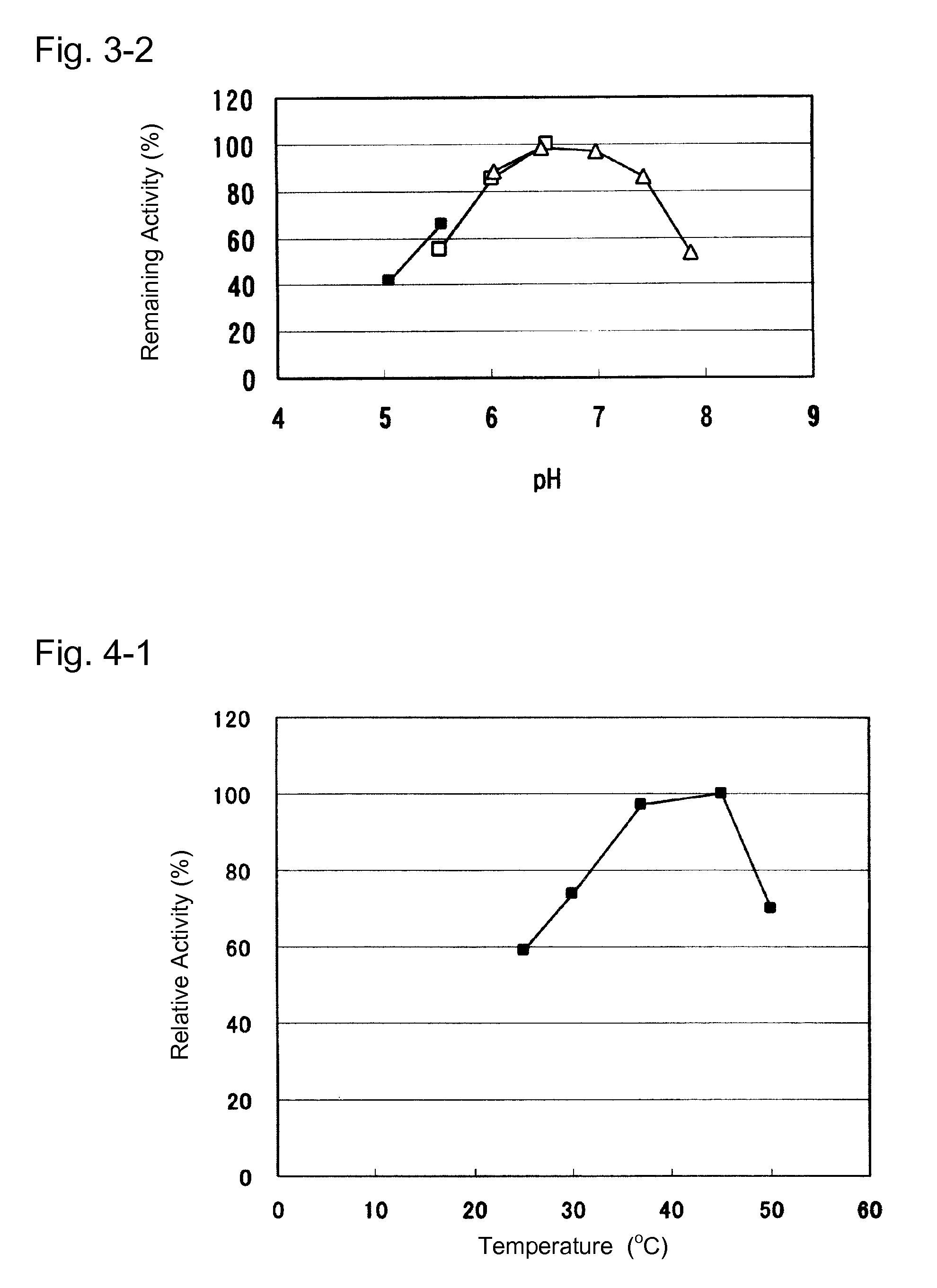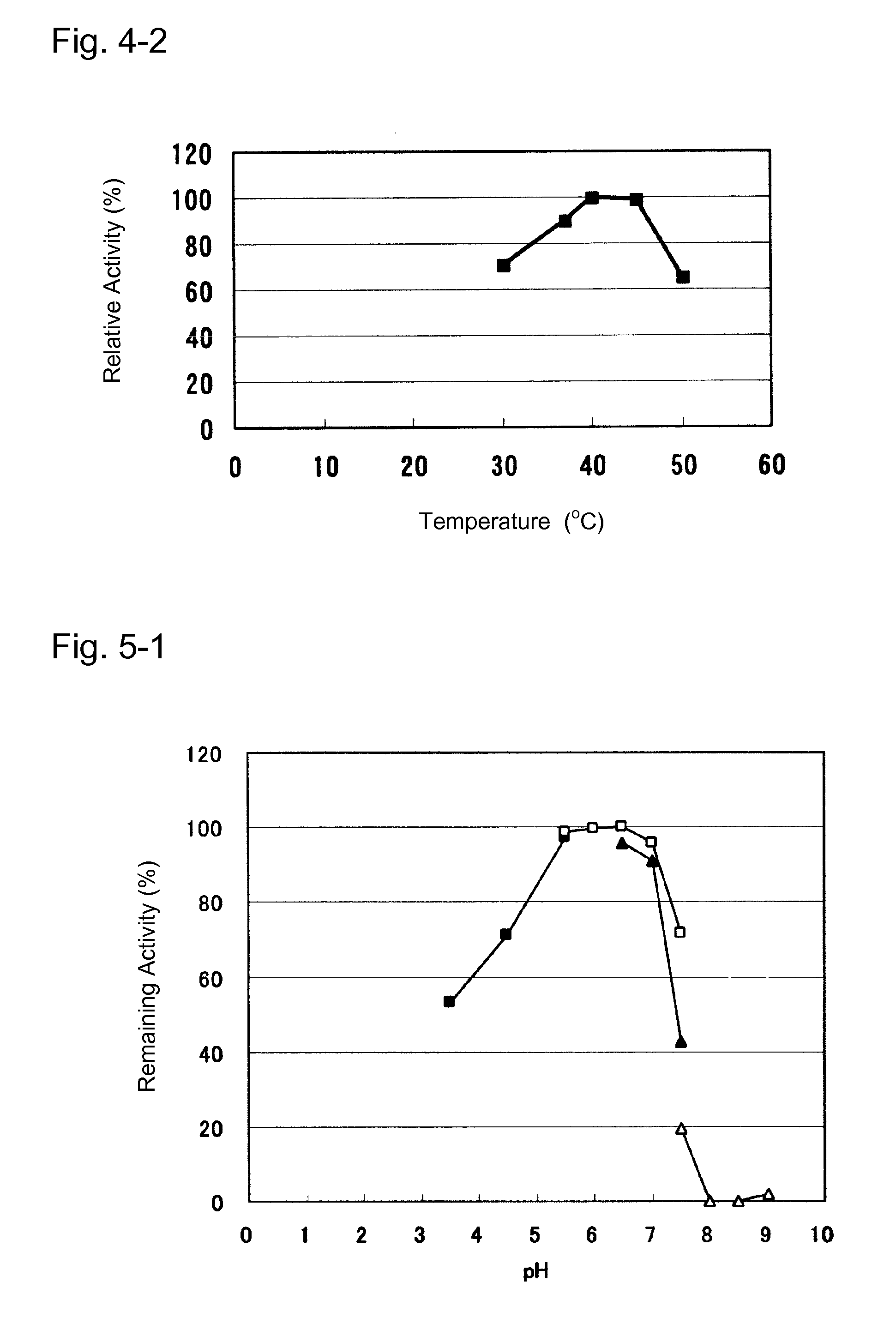Glucose dehydrogenase
a technology of glucose dehydrogenase and glucose, which is applied in the direction of oxidoreductase, enzymes, biochemistry apparatus and processes, etc., can solve the problems of affecting the measurement accuracy of blood glucose levels, dissolved oxygen in a measurement sample is likely to affect the measurement, and the method using gdh is also unsuitable for accurately measuring blood glucose levels, etc., to achieve accurate measurement, reduce reactivity to d-xylose, and high affinity to d-glu
- Summary
- Abstract
- Description
- Claims
- Application Information
AI Technical Summary
Benefits of technology
Problems solved by technology
Method used
Image
Examples
example 1
Reconstitution of Strain
[0168]Some strains that belong to the genus Circinella were obtained from the National Institute of Technology and Evaluation (an incorporated administrative agency). Ampules of L-dried strain samples were opened, and 100 μL of reconstitution water was supplied to each sample so as to suspend the dried cells in the water. Thereafter, each suspension was added to a reconstitution medium dropwise, and statically cultured at 25° C. for 3 to 7 days, thereby reconstituting the strain. Sterilized water (distilled water treated in an autoclave at 120° C. for 20 minutes) was used as reconstitution water, and DP medium (dextrin 2.0%, polypeptone 1.0%, KH2PO4 1.0%, agarose 1.5%) was used as reconstitution medium. 100 μL of each strain stocked in glycerol was reconstituted by being plated on DP agar medium.
example 2
Collection of Culture Supernatant
[0169]A loopful of each strain of the genus Circinella reconstituted in Example 1 was inoculated in a solid medium containing 2 g of wheat germ and 2 mL of water sterilized in an autoclave at 120° C. for 20 minutes, and was statically cultured at 25° C. for about 3 to 7 days. After the culture, 4 mL of 50 mM potassium phosphate buffer solution (pH of 6.0) containing 2 mM EDTA was added, and the cells were sufficiently suspended by vortex mixing. After a small amount of glass beads were added to the suspension, the cells were disrupted using a beads shocker (Yasui Kikai Corporation) at 3,000 rpm for 3 minutes, twice, followed by centrifugation for 5 minutes at 4° C., 2,000×g. The resulting supernatant was used as a crude enzyme solution.
example 3
Confirmation of Glucose Dehydrogenase Activity
[0170]The activity of glucose dehydrogenase in the crude enzyme solution obtained in Example 2 was measured according to the FGDH measurement method shown in Section 1-1 above. Table 1 shows the results.
[0171]
TABLE 1StrainActivity (U / ml)Circinella minor NBRC64480.01Circinella mucoroides NBRC44530.07Circinella muscae NBRC64100.04Circinella rigida NBRC64110.02Circinella simplex NBRC64120.46Circinella umbellata NBRC44520.03Circinella umbellata NBRC58420.02Circinella RD05542210.7
[0172]The results of Table 1 show that GDH activity was confirmed in the crude enzyme solutions from Circinella minor NBRC6448, Circinella mucoroides NBRC4453, Circinella muscae NBRC6410, Circinella rigida NBRC6411, Circinella simplex NBRC6412, Circinella umbellata NBRC4452, Circinella umbellata NBRC5842, and Circinella RD055422.
PUM
| Property | Measurement | Unit |
|---|---|---|
| molecular weight | aaaaa | aaaaa |
| wavelength | aaaaa | aaaaa |
| temperature | aaaaa | aaaaa |
Abstract
Description
Claims
Application Information
 Login to View More
Login to View More - R&D
- Intellectual Property
- Life Sciences
- Materials
- Tech Scout
- Unparalleled Data Quality
- Higher Quality Content
- 60% Fewer Hallucinations
Browse by: Latest US Patents, China's latest patents, Technical Efficacy Thesaurus, Application Domain, Technology Topic, Popular Technical Reports.
© 2025 PatSnap. All rights reserved.Legal|Privacy policy|Modern Slavery Act Transparency Statement|Sitemap|About US| Contact US: help@patsnap.com



